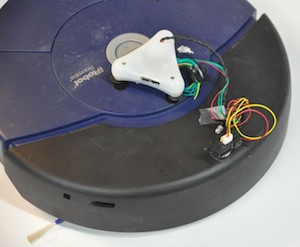Carnegie Mellon Controller Kit Adds Bluetooth Link for Appliances, Toys
- By Dian Schaffhauser
- 01/03/12

Brainlink allows users to turn their Android devices into controllers for a variety of toys, robots, or appliances. |
A start-up conceived at Carnegie Mellon University (CMU) has developed a $125 controller kit for cloning infrared remote control devices to enable a Google Android smartphone or laptop to control toys such as robots or home appliances. According to the developer, the product can be programmed to control a TV with voice commands, guide a robot with the light from a flashlight, or prevent an automatic vacuum from bumping into walls.
Brainlink from BirdBrain Technologies lets the user create new programs to add additional capabilities to his or her gadgets. For example, in a video on the Brainlink website, an Android phone is used as the remote to control the activities of a toy robot. Brainlink links devices outfitted with the controller to take commands from the Android phone or a computer via Bluetooth. The controller operates the devices using infrared signals, mimicking the signals of a device's original remote control.
The kit includes a light sensor and accelerometer and has ports for connecting additional sensors, so users can add capabilities to old devices. According to the company, the device will appeal most to "hackers with an intermediate level of programming experience."
"Millions of Robosapiens, Roombas and other consumer robots have been sold and many of these could serve as great platforms for education or research," said Tom Lauwers, a CMU alumnus and head of BirdBrain. "By giving these devices Bluetooth links to Android phones and laptops and adding ports for sensors, we can repurpose these robots in ways that couldn't have been foreseen when they were made."
The Brainlink system includes a small triangular controller that attaches to the object being controlled. Commands are relayed to the object's IR detector by way of an infrared LED connected to the unit. The controller, powered by a rechargeable battery, has a Bluetooth range of 30 feet.
Brainlink was developed with the financial support of a Small Business Innovation Research grant from the National Science Foundation.
As part of the grant, the software for Brainlink was developed by Christopher Bartley, principal research programmer in the CMU Robotics Institute's CREATE Lab, and Huaishu Peng, a master's degree student in the School of Architecture's Tangible Interaction Design program.
About the Author
Dian Schaffhauser is a former senior contributing editor for 1105 Media's education publications THE Journal, Campus Technology and Spaces4Learning.